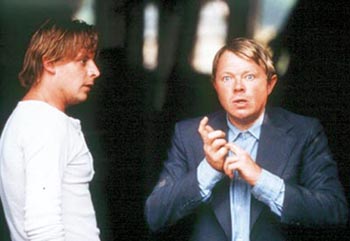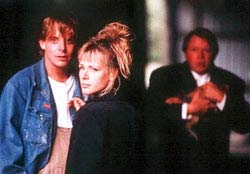
At what point does a movie become "independent"? This is not a low-culture/high-culture question--although it could be; today, though, I'm interested in what I wishe were something simple: the relationship between technique and meaning. More than a decade ago--and I'll never get tired of wondering where the years go--everyone who followed film trends weighed in on "Dogme '95," a movement that can in part be summed up in its rules, or "Vow of Chastity" (quoted from its website):
I swear to submit to the following set of rules drawn up and confirmed by DOGME 95:
1. Shooting must be done on location. Props and sets must not be brought in (if a particular prop is necessary for the story, a location must be chosen where this prop is to be found).
2. The sound must never be produced apart from the images or vice versa. (Music must not be used unless it occurs where the scene is being shot).
3. The camera must be hand-held. Any movement or immobility attainable in the hand is permitted. (The film must not take place where the camera is standing; shooting must take place where the film takes place).
4. The film must be in colour. Special lighting is not acceptable. (If there is too little light for exposure the scene must be cut or a single lamp be attached to the camera).
5. Optical work and filters are forbidden.
6. The film must not contain superficial action. (Murders, weapons, etc. must not occur.)
7. Temporal and geographical alienation are forbidden. (That is to say that the film takes place here and now.)
8. Genre movies are not acceptable.
9. The film format must be Academy 35 mm.
10. The director must not be credited.
And, best of all, a postscript:
Furthermore I swear as a director to refrain from personal taste! I am no longer an artist. I swear to refrain from creating a "work", as I regard the instant as more important than the whole. My supreme goal is to force the truth out of my characters and settings. I swear to do so by all the means available and at the cost of any good taste and any aesthetic considerations.
Thus I make my VOW OF CHASTITY.
 This was signed in Copenhagen, Monday, March 13, 1995, by Lars von Trier and Thomas Vinterberg. The website lists 101 films; I just saw the third, Mifune (1999), directed by Soren Kragh-Jacobsen. Kresten (Anders W. Berthelsen) has just married the boss' daughter, when he receives news that his father has died. The real news for his bride is that Kresten ever had a father; she is immediately off-put--then more so when she discovers Kresten had grown up on a farm, and oddly familiar yuppie-vs.-redneck classism hovers threateningly. It is a life Kresten is eager to divorce himself from; indeed, when he shows up, all it takes is two minutes in the farmhouse to make him throw up, little difference whether it's the smell of his laid-out father or the nausea of remembrance. And there are more uncovered secrets: Kresten has an adult, brain-damaged brother, Rud (Jesper Asholt), who makes crop circles and waits for the alien heroes from his comic books to arrive. And not only visitors from above, but below: When Rud is upset, to soothe him Kresten clambers down to the basement, there to confront "Mifune"--that's Toshiro Mifune, whom Kresten challengingly, joyfully greets as "you seventh samurai!" Kresten rushes up the stairs, a colander on his head, a pole in hand, gloves flapping like samurai-helmet-flaps alongside his ears--straight into Liva (Iben Hjejle), who has answered Kresten's more-than-slightly-misleading ad for a live-in housekeeper. She, too, has her own secrets: She is a prostitute from Copenhagen, tired of her life and frightened by a phone-stalker whose breathless verbal obscenities upset her more than the physical ones of her clients. She also has a brother, Bjarke (Emil Tarding), a wanna-be-hipster snob--and kind of a punk. He is kicked out of boarding school, and arrives at the farm, coiffed and disdainful in his black blazer; his sister comments to Kresten that he "looks like a Japanese tourist."
This was signed in Copenhagen, Monday, March 13, 1995, by Lars von Trier and Thomas Vinterberg. The website lists 101 films; I just saw the third, Mifune (1999), directed by Soren Kragh-Jacobsen. Kresten (Anders W. Berthelsen) has just married the boss' daughter, when he receives news that his father has died. The real news for his bride is that Kresten ever had a father; she is immediately off-put--then more so when she discovers Kresten had grown up on a farm, and oddly familiar yuppie-vs.-redneck classism hovers threateningly. It is a life Kresten is eager to divorce himself from; indeed, when he shows up, all it takes is two minutes in the farmhouse to make him throw up, little difference whether it's the smell of his laid-out father or the nausea of remembrance. And there are more uncovered secrets: Kresten has an adult, brain-damaged brother, Rud (Jesper Asholt), who makes crop circles and waits for the alien heroes from his comic books to arrive. And not only visitors from above, but below: When Rud is upset, to soothe him Kresten clambers down to the basement, there to confront "Mifune"--that's Toshiro Mifune, whom Kresten challengingly, joyfully greets as "you seventh samurai!" Kresten rushes up the stairs, a colander on his head, a pole in hand, gloves flapping like samurai-helmet-flaps alongside his ears--straight into Liva (Iben Hjejle), who has answered Kresten's more-than-slightly-misleading ad for a live-in housekeeper. She, too, has her own secrets: She is a prostitute from Copenhagen, tired of her life and frightened by a phone-stalker whose breathless verbal obscenities upset her more than the physical ones of her clients. She also has a brother, Bjarke (Emil Tarding), a wanna-be-hipster snob--and kind of a punk. He is kicked out of boarding school, and arrives at the farm, coiffed and disdainful in his black blazer; his sister comments to Kresten that he "looks like a Japanese tourist."The plot moves serio-comically toward various resolutions; on its surface it is a classic indie-film quirkball comedy, with a nasty jolt or two thrown in. But I think the Dogme vow has an influence on Mifune that distinguishes it and addresses the technique-meaning issue. In forcing the film to work within physical restrictions, the vow does encourage a kind of chastity: Kragh-Jacobsen's abstentionss seem to free the film--especially from genre restrictions (see #8). More than that, though, is the notion that the "artist" is encouraged to disappear; I think this too can be liberating. The symbolic gesture of erasing the director's credit uplifts the film with the freedom of anonymityy. Of course, none of this might matter--after all, we do know the director's name, and Mifune features what one could construe as "superficial action" (#6) (fisticuffs, a near-rape or two)--if it weren't for the largest concession, #3's handheld camera rule: "The film must not take place where the camera is standing; shooting must take place where the film takes place." Here, technique--or the lack thereof--and theme finally reach an agreement. And I assert this despite my unbounded admiration for the manipulators of cinema, from Chaplin to Ozu, Welles to Kubrick, Scorsese to, yes, even Tarantino, as hollow as his pictures may be. Watching Mifune, I was in a sense relieved that I did not have to stand in awe of craft, but passively consume the action, like the film's camera, which does become the servant of setting and character. The result is intimate, private cinema. The goofy qualities of the characters were not part of a larger worldview--a postmodern fragmentedd collage of hyper-realized culture/self-references, double-underlined by the camera, lighting, editing, ultra-processing; instead, the characters' quirks became their personalities, not our sideshow, and I could worry about and hate and love them on their own terms.
Hold on; this seems oddly familiar ...
John Cassavetes, you scamp! You already did this, maybe not entirely in 1959 with Shadows, but there it is in Faces (1968) and Husbands (1970) and A Woman Under the Influence (1974). He let everything else go--the camera, the music, the lighting, even the editing--for the sake of his actors, and in that sacrifice he does feel like Dogme 95's father, encouraging submission in the director. If Mifune, then, is an "independent" film, it's because of its independence, not from the evil studio and its money--the battle-cry of the indie-philes--and yes you can read such anti-Hollywood diatribes as well in Dogme 95 statements--but more so, in its ideal form, independence from the director.
 The religious language of Dogme seems apt, then, since its virtue lies in withholding technique in order to embrace--not "theme," the more I think of it, but "where the film takes place." And in many ways that place is first inside the actor's head, then into the camera, then the audience. What a relief Dogme must be; such surrender can be sweet liberation, just as Mifune's characters seek to free themselves from their own pasts--and, more critical, the futures others prescribe for them.
The religious language of Dogme seems apt, then, since its virtue lies in withholding technique in order to embrace--not "theme," the more I think of it, but "where the film takes place." And in many ways that place is first inside the actor's head, then into the camera, then the audience. What a relief Dogme must be; such surrender can be sweet liberation, just as Mifune's characters seek to free themselves from their own pasts--and, more critical, the futures others prescribe for them.
No comments:
Post a Comment